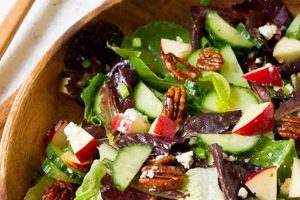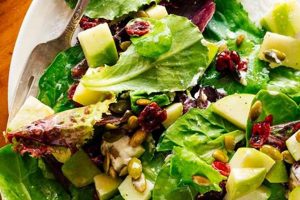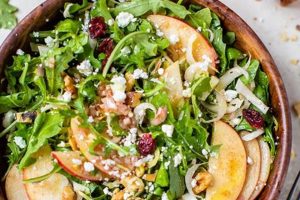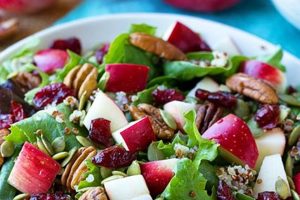A combination of shredded or diced apples and carrots forms the base of this refreshing dish. Variations often include additional ingredients such as raisins, nuts, seeds, or dried cranberries for added texture and flavor. Dressings typically range from light vinaigrettes to creamy mayonnaise-based options, enhancing the sweetness of the fruits and vegetables. A simple example includes grated apples and carrots tossed with a lemon vinaigrette, a sprinkle of walnuts, and a touch of honey.
This type of salad offers a balance of sweetness and crunch, providing a good source of vitamins, minerals, and fiber. The readily available ingredients contribute to its popularity as an easy and affordable dish, suitable for various occasions from everyday meals to festive gatherings. Historically, combining fruits and vegetables in salads has been a common culinary practice across cultures, reflecting seasonal availability and nutritional needs. These salads have evolved over time, influenced by regional preferences and culinary innovations.
The following sections will explore various aspects of this culinary creation, including specific ingredient combinations, diverse dressing options, and tips for preparation and presentation.
Tips for an Exceptional Apple and Carrot Salad
Achieving optimal flavor and texture requires attention to detail throughout the preparation process. The following tips offer guidance for creating a truly delightful salad.
Tip 1: Choose Crisp Apples: Select firm, tart apples such as Granny Smith, Honeycrisp, or Fuji. These varieties maintain their texture and provide a refreshing contrast to the sweetness of the carrots.
Tip 2: Grate or Dice Carrots Evenly: Uniformly sized carrots ensure even coating with the dressing and contribute to a pleasing texture. A food processor simplifies this step.
Tip 3: Prevent Browning: To prevent enzymatic browning, toss the cut apples with a small amount of lemon juice immediately after preparation. This maintains their appealing appearance.
Tip 4: Enhance with Dried Fruits and Nuts: Raisins, cranberries, chopped walnuts, or pecans add textural complexity and complementary flavors. Consider toasted nuts for enhanced aroma and crunch.
Tip 5: Explore Dressing Variations: Experiment with different dressings to find a preferred balance of sweet and tangy flavors. Vinaigrettes, creamy dressings, or even a simple drizzle of honey and lemon juice offer diverse options.
Tip 6: Chill Before Serving: Chilling the salad for at least 30 minutes allows the flavors to meld and enhances the refreshing qualities of the dish.
Tip 7: Garnish Thoughtfully: A sprinkle of fresh herbs like parsley or mint, or a dusting of cinnamon, adds a final touch of elegance and flavor.
By following these suggestions, one can elevate a simple combination of apples and carrots into a flavorful and visually appealing culinary experience. Attention to these details ensures a satisfying result.
These preparation strategies provide a solid foundation for crafting a delightful salad. The following section concludes with suggestions for incorporating this versatile dish into a variety of meal plans.
1. Ingredients
Ingredient selection significantly influences the final character of an apple and carrot salad. Careful consideration of each component contributes to the overall balance of flavors, textures, and nutritional value. The following facets highlight key ingredient categories and their impact on the finished dish.
- Apples
Apples provide sweetness and a contrasting tartness. Variety selection impacts both flavor and texture. For example, Granny Smith apples offer a tart flavor and firm texture, while Fuji apples contribute a sweeter, crisper profile. The chosen apple variety influences the salad’s overall sweetness and how well it holds its shape after being dressed.
- Carrots
Carrots offer sweetness, vibrant color, and a satisfying crunch. While typically orange, variations like purple or yellow carrots can introduce unique visual and flavor nuances. The carrots can be grated, shredded, or finely diced, impacting the salad’s texture.
- Additional Fruits and Vegetables
Incorporating other fruits and vegetables adds complexity and nutritional diversity. Raisins or dried cranberries contribute sweetness and chewiness. Celery or red onion introduces contrasting flavors and textures. These additions broaden the flavor profile and enhance the salad’s overall nutritional value.
- Nuts and Seeds
Nuts and seeds introduce healthy fats, protein, and textural contrast. Walnuts, pecans, or sunflower seeds provide crunch and complementary flavors. Toasted nuts offer a deeper, more intense flavor profile. These additions contribute to satiety and nutritional density.
The interplay of these ingredient categories determines the final flavor profile, texture, and nutritional value of the salad. A thoughtful combination of ingredients elevates the dish from a simple combination of produce to a complex and satisfying culinary experience. The following sections will explore preparation methods and dressing options, further demonstrating the impact of ingredient choices on the final result.
2. Preparation
Preparation methods significantly influence the final texture, flavor, and overall appeal of an apple and carrot salad. Careful consideration of cutting techniques, ingredient order, and timing contributes to a balanced and enjoyable sensory experience. This stage lays the groundwork for a successful dish, impacting both its aesthetic presentation and how the flavors meld together.
The choice between grating, shredding, or dicing the apples and carrots directly affects the salad’s texture. Grating creates a finer texture, allowing the dressing to coat the ingredients more evenly. Dicing, conversely, results in larger pieces, providing a more substantial bite. The size of the pieces also influences how well the ingredients retain their shape and texture, especially after being dressed and chilled. For instance, thinly sliced apples are more prone to softening than larger diced pieces. Additionally, the order of preparation matters. Apples, particularly varieties prone to browning, benefit from being tossed with a bit of lemon juice immediately after cutting to prevent oxidation. This preserves their fresh appearance and prevents discoloration.
Effective preparation streamlines the creation process and enhances the final product. It ensures consistent results, maximizes flavor development, and contributes to the salad’s visual appeal. Understanding the impact of each preparation step allows for greater control over the final outcome, ensuring a delicious and visually appealing salad. This attention to detail elevates the dish from a simple combination of ingredients to a carefully constructed culinary creation.
3. Dressing
Dressing is a critical component of an apple and carrot salad recipe, significantly influencing the final flavor profile and overall enjoyment. The choice of dressing complements and enhances the natural sweetness of the apples and carrots, while also adding acidity, creaminess, or other flavor dimensions. Careful selection creates a harmonious balance that elevates the salad beyond a simple combination of ingredients.
- Vinaigrettes
Vinaigrettes offer a light and tangy counterpoint to the sweetness of the fruits and vegetables. A classic vinaigrette, typically a blend of oil and vinegar, provides a refreshing acidity. Variations incorporating lemon juice, Dijon mustard, or herbs like dill or thyme introduce further complexity. The sharp notes of a vinaigrette cut through the sweetness of the salad, creating a balanced flavor profile.
- Creamy Dressings
Creamy dressings, often mayonnaise or yogurt-based, offer a richer, more decadent experience. These dressings provide a smooth, velvety texture that coats the ingredients, enhancing their mouthfeel. Incorporating ingredients like sour cream, Greek yogurt, or buttermilk contributes tanginess and balances the richness. Creamy dressings offer a textural contrast to the crispness of the apples and carrots.
- Flavor-Infused Dressings
Flavor-infused dressings introduce unique taste profiles that complement the core ingredients. Dressings incorporating maple syrup, honey, or citrus zest add layers of sweetness and complexity. Spicy dressings with a hint of chili or ginger provide a contrasting kick. These dressings can highlight specific flavor notes or introduce entirely new dimensions to the salad.
- Simple Dressings
Simple dressings highlight the natural flavors of the apples and carrots without overpowering them. A light drizzle of olive oil and a squeeze of lemon juice, or a sprinkle of cinnamon and a touch of honey, can be surprisingly effective. These minimalist approaches emphasize the inherent sweetness and crispness of the produce, allowing the natural flavors to shine through.
The dressing’s role extends beyond simply adding flavor; it contributes to the overall sensory experience, influencing texture, aroma, and visual appeal. Selecting a dressing that complements the other ingredients is essential for creating a well-balanced and satisfying apple and carrot salad. The interplay between the dressing and the core ingredients elevates the dish from a basic salad to a more refined culinary creation.
4. Presentation
Presentation elevates an apple and carrot salad from a simple dish to a visually appealing culinary experience. Consideration of color, texture, and serving style significantly impacts perceived freshness and overall enjoyment. Thoughtful presentation enhances the dining experience, encouraging appetite and appreciation for the culinary creation.
Visual appeal begins with ingredient selection. A variety of colors, such as incorporating orange carrots, red apples, and green herbs, creates a vibrant and enticing presentation. Textural contrast, achieved through a combination of grated carrots, diced apples, and chopped nuts, adds visual interest and stimulates the palate. The arrangement of ingredients, whether layered, tossed, or molded, further contributes to the salad’s aesthetic impact. Serving the salad in individual portions, on a bed of lettuce, or in a decorative bowl elevates the dining experience. Garnishing with fresh herbs, a sprinkle of spices, or a drizzle of dressing adds a final touch of elegance.
Practical applications extend to various settings, from casual meals to formal gatherings. For everyday dining, a simple arrangement in a bowl suffices. For more formal occasions, individual portions plated with artistic flair enhance the meal’s sophistication. Presentation adapts to the context, ensuring the salad complements the overall dining experience. Ultimately, attention to presentation transforms a basic apple and carrot salad into a visually captivating and memorable dish, enhancing enjoyment and appreciation for the culinary art involved.
5. Variations
Variations within apple and carrot salad recipes demonstrate the dish’s adaptability and versatility. Exploring these variations provides insight into how core ingredients can be complemented and enhanced through additions and substitutions, resulting in a wide range of flavor profiles and textural experiences. Understanding these possibilities allows for customization and caters to diverse palates and dietary preferences.
- Fruit Incorporations
Beyond the foundational apples, incorporating other fruits expands the flavor profile and nutritional value. Adding grapes introduces a juicy sweetness, while diced pineapple offers a tropical twist. Dried fruits such as cranberries or raisins provide concentrated sweetness and a chewy texture. These additions create complexity and offer a broader range of flavor combinations.
- Vegetable Additions
Introducing various vegetables enhances the salad’s nutritional content and textural complexity. Shredded red cabbage adds a vibrant color and peppery flavor, while chopped celery contributes a refreshing crunch. Grated beets offer an earthy sweetness and striking visual contrast. These additions create a more substantial and satisfying salad.
- Protein Enhancements
Adding protein transforms the salad into a more complete meal. Toasted nuts like walnuts or almonds provide healthy fats and satisfying crunch. Seeds such as sunflower or pumpkin seeds contribute protein and nutritional density. Crumbled feta cheese or grilled chicken or tofu can be incorporated for a more substantial protein boost, catering to different dietary preferences.
- Spice and Herb Infusions
Incorporating spices and herbs elevates the flavor profile and adds aromatic complexity. A dash of cinnamon complements the sweetness of the apples, while a sprinkle of ginger adds a warming note. Fresh herbs like mint, parsley, or cilantro introduce bright, refreshing flavors. These additions create depth and complexity within the overall flavor profile.
These variations highlight the adaptability of the apple and carrot salad, showcasing its potential to accommodate diverse tastes and dietary needs. From simple additions to more substantial modifications, each variation offers a unique culinary experience, demonstrating the versatility of this foundational recipe. The ability to personalize the salad ensures its continued relevance and appeal across a wide range of culinary preferences and occasions.
Frequently Asked Questions
This section addresses common inquiries regarding apple and carrot salads, offering concise and informative responses to clarify potential uncertainties and provide practical guidance for preparation and enjoyment.
Question 1: How can enzymatic browning of apples be prevented?
Tossing cut apples with a small amount of acidic juice, such as lemon or orange juice, immediately after preparation inhibits browning. This helps maintain the fruit’s fresh appearance.
Question 2: What are optimal apple varieties for this type of salad?
Crisp, tart apples like Granny Smith, Honeycrisp, or Braeburn maintain their texture and provide a balanced flavor profile. Softer varieties may become mushy.
Question 3: Can alternative sweeteners be used in dressings?
Honey, maple syrup, or agave nectar can substitute for refined sugar in dressings, offering nuanced sweetness and potential health benefits. The intensity of sweetness varies, requiring adjustments to the recipe.
Question 4: How long can the salad be stored?
Properly stored in an airtight container in the refrigerator, the salad maintains optimal quality for up to three days. Separation of dressing may occur, requiring gentle mixing before serving. Texture may soften slightly over time.
Question 5: What are suitable alternatives to nuts for individuals with allergies?
Sunflower seeds, pumpkin seeds, or roasted chickpeas offer similar textural benefits and nutritional value as nuts, while accommodating dietary restrictions. These substitutions maintain a satisfying crunch.
Question 6: How can this salad be adapted for different dietary needs?
Ingredient selection allows for customization to address specific dietary requirements. Using vegan mayonnaise or yogurt creates a plant-based version. Avoiding added sugars caters to low-sugar diets. Tailoring the recipe based on individual needs ensures inclusivity.
Addressing these common questions provides a comprehensive understanding of various facets of apple and carrot salad preparation and enjoyment. These insights empower individuals to create and enjoy this versatile dish tailored to their preferences.
The next section will provide a sample recipe incorporating the principles and suggestions discussed throughout this exploration.
Apple and Carrot Salad Recipe
Exploration of the apple and carrot salad recipe reveals a dish offering both simplicity and versatility. From ingredient selection and preparation techniques to dressing choices and presentation styles, each element contributes to the final culinary outcome. Emphasis on fresh, crisp produce, balanced flavor profiles, and considered presentation elevates this combination beyond basic ingredients, showcasing its adaptability to diverse tastes and dietary preferences. The variations presented demonstrate the potential for customization, highlighting the recipe’s enduring appeal.
The apple and carrot salad recipe stands as a testament to the potential found within simple, readily available ingredients. Culinary exploration of this recipe encourages creativity and appreciation for the nuanced interplay of flavors and textures. Continued experimentation with variations and personalized adaptations ensures this classic dish remains a vibrant and evolving culinary staple.






